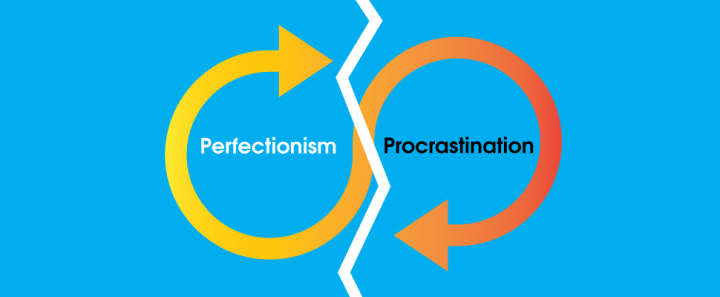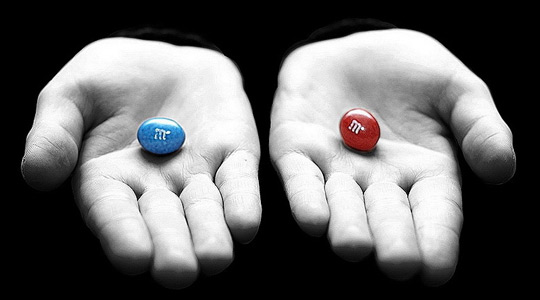Breaking the Perfectionism-Procrastination Infinite Loop

Putting it off doesn’t make it go away. Getting it done does.
— Ned Hallowell, Driven to Distraction
You get out of the meeting with your client, full of ideas and energy about what you’re going to do next. You commit to a deadline for ideas, a proposal, designs — some kind of deliverable to move the project forward. In your mind, at that moment, it’s all crystal clear and you can’t wait to work on it.
But as the date looms closer, something changes. You want it to be amazing, fantastic, flawless. Even though your vision is clear and your ideas solid, you keep delaying the start of the process. The excitement that you initially felt begins to feel like dread. “I have to do more research, gather more information, find more sources of inspiration before I start so it can be really good. I’ll get started tomorrow — I’ve got time,” you tell yourself.
Finally, it’s the day before the due date. You’re now kicking yourself for putting it off and your sense of self flags along with your motivation to act. And then it’s the due date. You’re now not only beating yourself up for potentially messing up a big opportunity, but also panicking and stressing to pull it together by the end of the day.
I’d like to introduce you the twins that just wreaked havoc upon your nerves and your work: perfectionism and procrastination.
Perfection Is Good?
Everyone knows that procrastination is bad. But perfectionism is fine, right? Wrong. Both are fraught with difficulty, and they tend to appear together, forming an infinite loop that can destroy your productivity and your psyche.
Of the two, perfectionism seems to be more subtle and difficult to identify. How do you determine whether you are of the perfectionism persuasion?
- Perfectionists tend to focus on product to the exclusion of the process, and those results better be successful.
- Despite often being high achievers, perfectionists’ feelings of satisfaction about achievement are temporary because they believe there is always more to do, be and accomplish.
- Perfectionists are their own harshest critics, frequently berating themselves over any small things that went wrong.
- Perfectionists tend to do things in fits and spurts, starting off gangbusters, only to collapse in exhaustion.
This unreasonable striving for perfection stems from attempts to preserve a sense of self-worth that hinges on the expectations of others. It is often referred to as “the highest form of self-abuse” because perfection simply doesn’t exist. More importantly, perfection is rarely necessary in day-to-day working and living (unless you are a brain surgeon).
The most pernicious reality of being a perfectionist is that perfectionists procrastinate.
The Procrastination Hangover

Procrastination is often a symptom of perfectionism. Because perfectionists fear being unable to complete a task perfectly, they put it off as long as possible. This stems from the fear that not meeting the goal means that there is something bad, wrong or unworthy inside of them. Further, perfectionists fear that failure will invoke criticism or ridicule either from internal voices or external authorities and peers. The higher the fear of failure and ridicule, the more perfectionists procrastinate.
To clarify, procrastination is not laziness. It’s more a misguided sense of activity based on a low tolerance for frustration and failure. When people perceive a higher challenge than they feel capable of, they sidestep the discomfort through diversion. Studies reveal a cognitive aspect as well: people procrastinate when they view concrete tasks in abstract terms. For example, when you delay completing a task that seems like it will take a really long time, only to realize that it took less time to do it than to think about it repeatedly.
Procrastination is easy to spot: Are you doing what you want to be doing or are supposed to be doing, or are you surfing the web/reading Facebook posts/filing papers/doing laundry/running errands? If you answered yes to the latter, then you are procrastinating. While it is amusing to figure out what form of procrastination you’re engaged in, it’s more important to determine the cause of your procrastination.
There are several common causes of procrastination, including:
- Complicated task anxiety
- Fear of imperfection
- Lack of self-confidence
- Priority confusion
- Lack of focus
- Indecision
- Boredom from minutiae
This can be further simplified to three reasons why people procrastinate: either they don’t know what to do, they don’t know how to do it, or they don’t enjoy doing it.
Why Break the Loop?
Despite the negative repercussions of perfectionism and procrastination, it is a cycle people return to simply because it is what they know. But it is critical to break the loop. For one, you waste valuable time beating yourself up mentally by putting off tasks that you signed yourself up to do. And by “valuable time,” I mean it in the grandest sense that you have a finite amount of time on the planet. Do you really want to look at all your friends’ Facebook posts instead of writing the proposal for a potential new client?
Another reason to break the loop is that perfectionism (and the procrastination that results from it) is the enemy of creativity, productivity and sanity. Because perfectionists are so concerned with the outcome being just right, they are victims of risk-averse thinking, which inhibits innovation and creativity. Ironically, successful perfectionist-procrastinators are actually successful in spite of their behaviors, not because of them.
Finally, both perfectionism and procrastination have longer-term tolls on both mental and physical health. The dysfunctional thinking of perfectionism can be toxic, often leading to discouragement, self-doubt and mental exhaustion. Procrastination is equally damaging. Not only do procrastinators squander their precious resources of time, attention and focus, but the constant stress caused by procrastination eventually leads to problems like compromised immunity, digestive problems and insomnia.
I Want a New Drug

Because perfectionism and procrastination are products of fears gone wild in the brain, methods to break the infinite loop are bait-and-switch tactics that distract the brain from the fears long enough to focus on what needs to be done. The thinking that promotes procrastination exaggerates the scale of tasks involved, and these tricks work to shrink them back down to normal size. When you make efforts to break the cycle, you’ll be shocked at how much easier the tasks are and how little time tasks actually take compared to your looming mental image of them.
Shift Perceptions
Here are some tips to beat perfectionism-based procrastination that stems from fears about how you will be judged or perceived by others:
- Get in touch with the value of what you’re doing. When you find yourself back on Facebook (again) instead of doing something that will move you forward, take a moment to think about how the tasks ahead fit in the grand scheme of your life. The more meaningful the task is in terms of forward movement, the less likely you will be to procrastinate.
- Be aware of unrealistic expectations, and break your brain out of black-and-white thinking about expectations. Consider the Best/Worst/Real exercise: whatever tasks you feel compelled to do perfectly (and thus are procrastinating on), write down what you believe could be the Best Case Scenario, the Worst Case Scenario, and what is most likely the Realistic Scenario, which will be neutral.
- Remember that no one else cares and no one else matters. Most people are so wrapped up with themselves that they won’t notice any “slip” on your part. Let your desire to impress others go, and decouple your performance from your sense of self-worth.
- Understand the difference between excellence and perfection. Excellence stems from enjoying and learning from an experience, and developing confidence from it. In stark contrast, perfection fosters negative feelings from any perceived mistakes made, regardless of the excellence of performance.
Go for Good Enough

When your fears center on whether what you produce will be “good enough,” here are some tips to entice your brain into thinking differently:
- Don’t wait for conditions to be perfect to get started. Trust that you have everything that you need to get going on the task, and that you will discover any additional resources that you need once you get started.
- Accept that it will never be perfect by “satisficing.” When you satisfice, you aim for satisfactorily sufficient results and nothing more. This is especially useful if you, your team or your company struggles with the “it has to be perfect before we launch” attitude. Keep in mind that you have to start somewhere. Many ridiculously successful ventures have had humble beginnings, and your project is no different. Keep the directive of Make. Do. in mind. You can always iterate upon your creation later, but get it out the door — don’t wait until it’s flawless. By then, it may be too late.
- Geek out by applying Design Thinking principles to your compulsion for perfection. With design thinking, the process is as important as the product. Instead of focusing on (and fearing “failure” around) the outcome, focus instead on the five steps of design thinking: discovery, interpretation, ideation, experimentation/testing and evolution/iteration.
Doing any or all of the above will start to help you break perfectionistic tendencies, but these next suggestions will more directly dismantle the foundations of procrastination.
Analyze your Anxiety
To get to the source of your resistance to getting to the task, you may need to do some analysis. Consider two exercises that can help:
- Action-anxiety rubric:
Take a sheet of paper and draw a line down the middle. In the first column, list the tasks that you are blocked on and are putting off. In the second column, write down the anxiety, concerns, worries or fears you have about doing that task. Start anywhere and write down as much as you can. - Task/steps > Anticipated Problems:
Another version of this is to list the task and the steps involved with each task, and the problems you anticipate encountering when executing the task or step.
Eliminate Distractions
Pruning away the unnecessary can mitigate the overwhelming thoughts and feelings that lead to procrastination:
- Clear your space of distractions, and delegate, drop and delete anything that doesn’t contribute to your goals.
- Sequester yourself. Gather only what you need to work on the task, take yourself out of your normal work environment and go to a conference room, another office, the library, a co-working space, a friend’s house — anywhere where you will not be distracted by your normal routine and people that you know.
- Firewall technology. Use one of the great apps or browser extensions that block you from the lure of distracting websites. Turn off your phone’s ringer or put it in airplane mode to block out all notifications.
Trick Your Mind

If you’re procrastinating because of fears of failure, you can use action to cure fear with some of these action-based mind tricks:
- Pretend you’re not going to do it by “getting ready” to do it. Instead of writing the proposal, just get ready to write it by jotting down a few ideas. While you’re at it, you might go ahead and get ready for writing it by doing a relevant web search for supporting information. And so on. Eventually, the line will blur between the getting ready for doing it, and actually doing it.
- Practice structured procrastination: put the most important thing at the top of the list and other important things that need to get done under it. Even if you don’t do the top thing and go to the others, you’re still getting important items done.
- Another version of structured procrastination can be to leverage the power of what I like to call “white space creativity”. Good ideas often come when engaging in mindless activities like washing the dishes, gardening and organizing. The trick is to use these activities as tools for generating ideas, not as ways to escape tasks.
Put Time on Your Side

One major contributor to procrastination is uncertainty: having a hazy sense of how long the task will take usually makes it seem larger and more involved than it turns out to be. Establishing a better sense of time can help thwart procrastination.
The first step is to take the seemingly insurmountable task and break it into smaller pieces or steps. The next step is determine the time of the task yourself by assigning it a set time or giving yourself a quota:
- Give yourself five minutes or ten minutes of focus. You can shoulder through anything for 5-10 minutes, right? Devoting even a small amount of focus will break the siren call of pushing it off and get you on track to completing the task.
- Employ the pomodoro technique or Merlin Mann’s (10+2)*5 . Both employ having a set amount of time with one segment being a “sprint” and the other a rest. Pomodoro uses 30m with 25m for the sprint, and 5m for the break. (10+2)*5 is 10m sprint, a 2m break done 5 times to equal an hour.
- Fill a quota by running dashes. Here, you can build in your own breaks, but the important part is determine your quota and stick to it. Maybe it’s responding to 10 emails, or doing a 15m sprint, or working until a certain time. Determine your quota, stick with it, and reward yourself at the end.
- A single day for a single task: schedule doing the task, and only that task, for a certain day. Put it on your calendar. Pro tip: combine this with sequestering yourself (above).
Ready, set, GO!
Once you recognize a problem, you can start to solve it. While perfectionism and procrastination may have plagued you in the past, you now have the tools to create a new future — not tomorrow, but today.
Going the Extra Mile
Want to up the ante even more? They say it takes an entire village to raise a child, so in my mind, the same goes for helping someone break free of the tyranny of perfectionism and procrastination. Enlist other people in your process and make yourself accountable for the task(s) by partnering up with a friend. You could also publicly enlist the support of people in your social networks. Avoid this, however, if that will lead you back into distraction temptation.
Pitfalls to Avoid:
- Do not get discouraged. Remember, breaking the loop is a process. It will take time to break years of old habits.
- Do not beat yourself up if and when you fall back into procrastination mode. Recognize that you are doing it and commit to trying one or more of the tips suggested in this article.
Things to Do:
- Identify what the source is of your anxiety around completing the task(s) that you are putting off.
- Make a commitment to become aware of the thinking that causes you to procrastinate.
- Eliminate as many distractions as possible.
- Put time on your side with breaking down tasks and devoting controlled amounts of time to them.
Further Reading
- Banish Your Inner Critic, by Denise Jacobs, Mango Media, 2017
- Banish Your Inner Critic presentation at Design/Content 2015
- The Gifts of Imperfection: Let Go of Who You Think You’re Supposed to Be and Embrace Who You Are, by Brené Brown, 2010
- The Procrastination Equation: How to Stop Putting Things Off and Start Getting Stuff Done, by Piers Steel , 2010
- The Now Habit: A Strategic Program for Overcoming Procrastination and Enjoying Guilt-Free Play, by Neil Fiore, PhD., 2007
- Zen To Done: The Ultimate Simple Productivity System, by Leo Babauta 2012
- Mindset: The New Psychology of Success, by Carol Dweck, 2007
This article was originally published on Web Standards Sherpa. Reprinted with permission.









2 Comments
Nichole | Wildly Alive
April 4, 2019Thanks for sharing. Such a great post! And the tips and advises are really helpful. And yes its not easy being a perfectionist. But aiming for realistic goals,. slowly but surely. It will make a huge difference to make ourselves good enough and not being too perfectionist. And we should allow ourselves to be human. Always be kind to yourself.
6 WAYS LEADERS CAN START BANISHING THEIR INNER CRITIC - Denise Jacobs
March 8, 2020[…] important to realize and understand that perfection and excellence are two totally different things. You can actually do something really well but it doesn’t mean it has to be “perfect.” […]